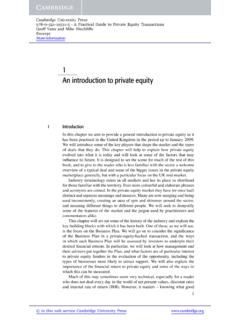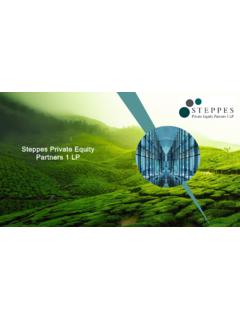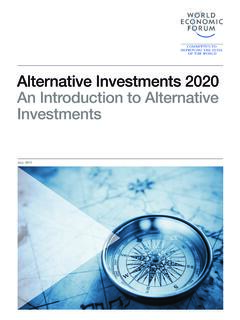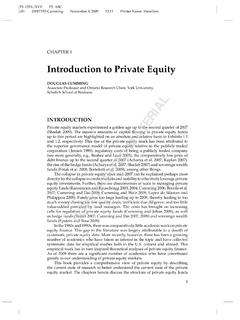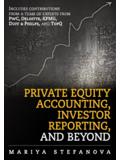Transcription of Introduction to Private Equity Funds - legacy.pli.edu
1 Chapter 1 Introduction toPrivate Equity Funds 1:1A Brief History of Private Equity 1 World War II: American Research and Development 1 Business Administration 1 Seventies: Favorable Legislation 1 Eighties: Leveraged Buyouts 1 Nineties: Technology Industry 1 New Millennium: Securitization Market 1 Subprime Mortgage Crisis 1 European Sovereign Debt Crisis 1 Investment Climate 1:2 What Is a Private Equity Fund? 1 1 Investments[A]Diversified Portfolio[B]Deal Structures[C]Types of Investments 1 Structure 1 Placements 1 Players[A]Fund Sponsors[B]Investors[C]Professional Advisors[D]Placement Agents 1:3 Types of Funds 1 Funds [A]Typical Investments[B]Distinguishing Organizational Features[C]Activist Funds 1 Capital Funds [A]Typical Investments[B]Distinguishing Organizational Features1 1( Private Equity , 2nd ed., 11/16) 1 and Credit Opportunity Funds [A]Typical Investments[A][1]Mezzanine Funds [A][2]Credit Opportunity Funds [B]Distinguishing Organizational Features 1 Debt Funds [A]Typical Investments[B]Distinguishing Organizational Features 1 Estate Funds [A]Typical Investments[B]Distinguishing Organizational Features 1 of Funds [A]Typical Investments[B]Distinguishing Organizational Features 1 Product Funds [A]Typical Investments[B]Distinguishing Organizational Features 1 Club or Pledge Funds [A]Typical Investments 1:4 Other Investment Strategies in Private Equity 1 Investments in Public Equity (PIPEs) 1 Purpose Acquisition Company (SPAC)[A]Investment Advantages[B]Structural Considerations[C]Investment Risks 1 and Credit Opportunity Funds 1 Wealth Funds (SWFs)[A]Foreign Policy Concerns with SWFs 1 1 Funds 1 Capital Funds 1 Capital 1 of Existing and New Deals Post Financial Crisis[A]Existing Deals[B]New Deals 1.
2 5 Current Trends in Fundraising 1 1 Sources of Capital; Co-Investors 1 Terms Bargaining Power of Limited Partners 1 Periods 1:6 Industry Convergence 1 the Line Between Private Equity and Hedge Funds [A]Strategic Differences[B]Erosion of Differences Between Private Equity andHedge Funds [C]Advantages of Convergence[D]Convergence ConcernsPRIVATEEQUITYFUNDS1 2[D][1]Valuation of Fund Assets and Computation ofCompensation[D][2]Cultural Clash[D][3]Marketing Issues[D][4]Investor Expectations 1 Funds 1 Equity Funds Versus Mutual Funds 1:1A Brief History of Private EquitySome quip that the first Private Equity investment can be traced toChristopher Columbus, an undeterred young entrepreneur solicitingcapital from the Spanish royalty with an overly ambitious businessplan and a limited track record of , an analysis of thehistory of modern Private Equity the industry of providing invest-ment capital to a business in exchange for a share of the profits of therecipient entity begins in New England in the years immediatelyfollowing World War II.
3 1 World War II: American Research andDevelopmentFor decades, wealthy individuals such as the Rockefellers and had been investing in Private Equity , but the tide was about toturn in the nature of the investments and the profile of the postwar years engendered a new type of Private Equity investor apartnership built with investment capital from outside sources to bemanaged by individuals whose expertise (as well as capital) wouldsubstantially increase the growth of fledgling transformation came as a result of a number of factors. In theearly to mid-twentieth century, industry in New England had sloweddown considerably, particularly during the Great Depression. Manybusinessmen were rightly concerned that the economic revitalizationthat World War II had brought to the region would falter in the postwaryears. Furthermore, due to wartime-related research and what wasquickly becoming the frenetic race to be technologically superior toother nations, a number of exciting new technologies had beenrecently technologies needed Funds for developmentand marketing to the general public.
4 A group of New Englandbusinessmen identified the promising nature of these Dixit, Private Equity , Now in 3D, STAN. BUS. REP. (June 4, 2007). E. Ante,The Matchmaker of the Modern Economy, HARV. WORKINGKNOWLEDGE(Apr. 9, 2008), 1 to Private Equity Funds1 3( Private Equity , 2nd ed., 11/16)and discovered a major hurdle facing small development order to expand their business, they required either Equity or long-term capital but the provision of such financing was outside thenormal function of banks. 3In order to capitalize on profits andgrowth, an entity that could provide this type of financing as well asmanagement advice and experience to fledgling businesses would , American Research and Development, the first modern venture capital firm, was born. Started in 1946 by Georges Doriot,Ralph Flanders, Karl Compton and Merrill Griswold as an organiza-tion with a novel mission, American Research and Development(ARD) struggled to define itself and its purpose.
5 Its innovative modelwas often misunderstood and risked comparisons with other moretraditional investment companies. The difference, ARD argued, wasnot just the assumption of higher risk investments but the firm sactive participation in managing the investments that was critical totheir philosophy and stressed the virtues of goodmanagement, Always consider investing in a grade A man with agrade B idea. Never invest in a grade B man with a grade A idea. 5 1 Business AdministrationAmerican Research and Development changed the landscape ofAmerican business, moving away from large conglomerates towardfast-growing start-up companies. ARD was extremely profitable,6andits success largely encouraged Congress to pass the Small BusinessInvestment Act of was interested in the ARD modelfor engendering growth and believed that a government partnershipwith venture capital firms would flourish. Realizing that money forventure or risk investments is difficult for small firms to obtain, theSmall Business Administration enacted a program to provide H.
6 Hsu & Martin Kenney,Organizing Venture Capital: The Rise andDemise of American Research & Development Corporation, 1946 1973,14 INDUS. & CORP. CHANGE579 (2005). Cosenza,Co-Invest at Your Own Risk: An Exploration ofPotential Remedial Theories for Breaches of Rights of First Refusal in theVenture Capital Context, 55 AM. U. L. REV. 87, 144 (2006). D. Bygrave,The Entrepreneurial Process, inTHEPORTABLEMBAINENTREPRENEURSHIP12 (William D. Bygrave & Andrew Zacharakis eds.,3d ed. 2004). Kenney,Note on Venture Capital (The Berkeley Roundtable onthe Int l Economy, Working Paper No. 142, 2000) [hereinafter Kenney].ARD s investment of $70,000 in Digital Equipment Corporation in 1958grew to $350 million in Business Investment Act of 1958, Pub. L. No. 85-699, 72 Stat. 689(Aug. 21, 1958). 1 4assistance to Small Business Investment Companies (SBICs) to sup-plement the influx of Private Equity and long-term loan Funds to newcompanies. In return, companies that participated in the SBIC pro-gram were able to borrow Funds at favorable rates through the SmallBusiness Administration s (SBA) guarantee of SBIC debentures, whichwere ultimately sold to Private SBA legislation allowed venture capital firms to obtain fourdollars of government debt for each dollar of privately invested capitalin the fund (now two-for-one).
7 This cheap government money spurreda great deal of investment and caused people to leave the bankingindustry in droves for Private Equity jobs (a trend that would reoccurwith the LBO frenzy of the 1980s, the Internet bubble in the 1990s andthe housing/structured products boom of the 2000s).By 1962, there were almost 600 SBICs, with many facing seriousfinancial difficulties. By democratizing finance, 9 ARD made theviability of making significant profits from venture capitalism seempossible for anyone. The problems were twofold: first, that the disciplesof the ARD model failed to underscore the management expertise aspect of their equation (an ironic omission in that its foundersdistinguished themselves on that very nuance); and second, that thegovernment did not understand the economies of scale associated withventure capital , the debt service requirements to maintain govern-ment debt were better suited for more mature companies and, as aresult, investments in early-stage companies made with loans from theSBA faltered.
8 Although government financing was cheap and easy toobtain, the SBA retained a great deal of oversight and required thecompanies so financed to reach certain government-created bench-marks in a specified amount of 1965, over 230 of the SBICs defaulted on their loan obligations,which resulted in the vast overshadowing of the SBIC program by theprivate venture capital industry. Government financing, which offeredonly debt at favorable rates, was unable to compete with venturecapital firms who offered Equity to new , thefederal government conceded that it was ill-equipped to finance Business Investment Company (SBIC) Program (Minority Bus. Dec. 29, 2003). Kirsner,Venture Capital s Grandfather, BOS. GLOBE(Apr. 6, 2008), BEAN, BIGGOVERNMENT ANDAFFIRMATIVEACTION: THESCANDALOUSHISTORY OF THESMALLBUSINESSADMINISTRATION57 59(2001). 1 to Private Equity Funds1 5( Private Equity , 2nd ed., 11/16)type of industry and ceased to provide financing,12leaving this form ofinvesting in Private hands.
9 1 Seventies: Favorable LegislationFollowing a number of years of minimal Private Equity -basedfinancing, several pieces of legislation in the 1970s were enactedthat encouraged the Private Equity industry and fostered its on institutional investing were relaxed. The 1978 RevenueAct13reduced the long-term capital gains tax rate from to 28%,creating incentives for both investors and 1979, capital commitments to Private Equity Funds skyrocketed,representing a 1,000% increase over the previous alsorejected the limitations that the Investment Company Act of 1940, asamended (the Investment Company Act ),15placed on the regulationof a public vehicle in Private Equity . The restrictions prevented open-end investment companies from investing in young companies due totheir inherent need for liquidity. Furthermore, the Investment Com-pany Act s draconian limitations on compensation and effectiveborrowing precluded investment companies from providing financingto these new enacted the Small Business Investment Incentive Act of198016to promote public investment in Private companies and toremove the obstacles in obtaining capital sources through the use of anentity called the business development company (BDC), a closed-endinvestment company subject to the Investment Company Act.
10 Thistype of investment vehicle had relaxed borrowing requirements andpermitted a compensation structure that was in accordance with thecurrent standard in the venture capital investor incentive was the Economic Recovery Tax Act of1981 (ERTA),17which reduced the long-term capital gains tax ratefrom 28% to 20%, significantly benefiting large firms making con-siderable capital legislation encouraged ,supranote Act of 1978, Pub. L. No. 95-600, 92 Stat. 2763 (Nov. 6, 1978). Carragher & Darren Kelly,An Evaluative Comparison of the Cana-dian and American Private Equity Markets, J. PRIV. Equity (Spring 1998). Company Act of 1940, Pub. L. No. 768, 54 Stat. 800 (Aug. 22,1940). Business Investment Incentive Act of 1980, Pub. L. No. 96-477, 94 Stat. 2275 (Oct. 21, 1980). Recovery Tax Act of 1981, Pub. L. No. 97-34, 95 Stat. 172(Aug. 13, 1981). , 104 THCONG., : LESSONS FORTAXREFORM(1996). 1 6equity investments19and set the stage for the explosive growth of theventure capital and leveraged buyout industry in the 1980s.

